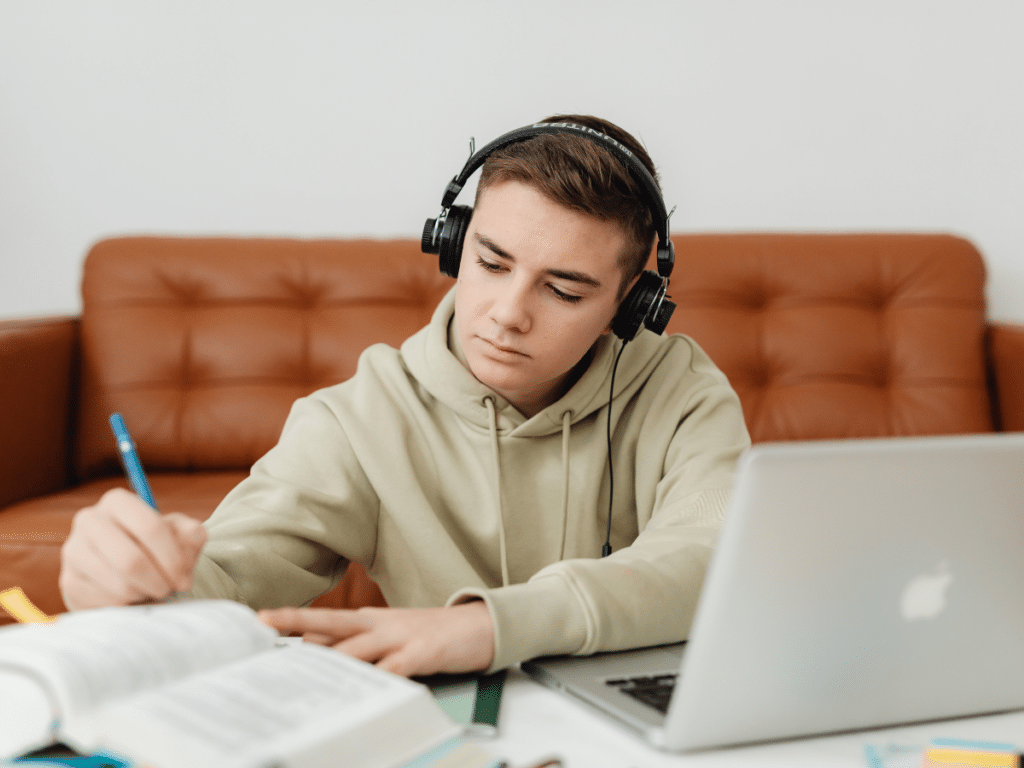Good mental health in teens generally means that they feel able to cope, recognize their strengths, and manage their emotions – both positive and negative ones. However, if a teenager finds their emotions, thoughts, and actions difficult to cope with, it can affect their ability to enjoy life and achieve goals.
Managing mental health can sometimes feel like dressing for unpredictable weather; we don’t know whether it’s going to rain or if the sun will peek through the clouds. However, activities that help teens understand and cope with their emotions can promote better well-being – even when times feel challenging.
The following mental health activities for teens can help you or someone you care about look after your well-being and feel confident and capable of dealing with life.
10 Mental Health Activities for Teens
1. Track Your Mood1
Negative emotions and moods can sometimes creep up on us without us fully understanding why. Tracking your mood throughout the day can be a simple, yet effective way to build awareness of what triggers feelings of overwhelm or stress.
In a notebook or app, record how you feel throughout the day using one-word descriptions. For example, “tired,” “anxious,” “stressed,” or “sad.” You can also use positive words such as “happy,” or “excited” when appropriate. Over time, you’ll likely notice a pattern in when and where you feel negative or positive – and how to put strategies into place during negative times to help you feel better.
2. Practice Calming Techniques2,3
Relaxation techniques can help calm difficult emotions and slow down busy thoughts which can lead to stress. Meditation, muscle relaxation, and mindfulness are great ways to calm emotions, but breathing exercises can be practiced anywhere, at any time. For instance, “square breathing” involves breathing in for four seconds, holding your breath for a count of four, breathing out for four, and pausing for four before breathing in again.
Focusing on this count can distract you from negative thoughts, while deep breathing calms the nervous system.
3. Create a Mental Health Playlist4
We tend to attach to certain songs and bands as teenagers more than at any other point in life. So, mindfully listening to your favorite songs may help you work through problems, provide a sense of healing, and even help you figure out who you are.
Creating a mental health playlist is simple: think of songs that make you feel inspired, happy, understood, or calm. Put these together in a playlist. Then, during moments of stress or upset, select a space free from distractions, press play, and just listen to the lyrics, notes, and melody. Pay attention to how your body feels before, during, and after the playlist – without judgment or self-criticism.
It might help to create different playlists for different moods. For example, if you’re feeling angry, listening to a happy song might make you feel invalidated. Instead, perhaps make playlists that work for varying occasions. For instance, a “happy” playlist, “sad” playlist, “creative” playlist, and so on.
4. Tap Into Your Creative Side5,6

Art can be an excellent way to release stress and improve mental health.The American Art Therapy Association describes art as a way to improve the ability to think clearly, build self-esteem and social skills, and reduce distress.
There are many different ways of using art to improve mental health. For example, you could draw or paint about how you feel, take photos of nature, or create a self-portrait of how you want to see yourself. It doesn’t matter if you don’t think you’re very good at art – all that matters is that you’re expressing yourself.
5. Try Grounding7
Stress and anxiety can make us feel like we’re not present in our lives – like we’re “unreal” or “cut off.” Grounding can help you feel more present in the “here and now” and distract you from worries about the present, past, or future. There are a lot of grounding techniques, but physical grounding strategies require using your five senses to help you through times of distress. For example, you could hold an ice cube and pay attention to how it feels at first, how long it takes to melt, and how the sensations in your hand change.
6. Make a Gratitude Box8
Creating reminders about what you’re grateful for and why can have an excellent effect on your well-being and positivity – and a gratitude box is simple to create. First, find a small box such as a shoebox. If you like, decorate it however you see fit. For example, you could paint it, put stickers on it, or just keep it plain.
Every day, take three pieces of paper and write three things you’re grateful for. These could be simple things, such as having a good conversation with a friend, a meal you enjoyed, or cuddling with a pet. Alternatively, they can be big things like the love of a family member. It can help to write these things down in the evening when you can better reflect on the day. Once you have written down three things you’re grateful for, put them in your box.
In time, the items in the box can serve as reminders of things to be thankful for in life. Whenever you’re having a tough day or are feeling a little down, take a few pieces of paper from the box and read them.
7. Do a Self-Care Checkup9
While factors such as sleep, eating well, and exercise are clearly connected to feeling good, during times of stress, they can be neglected. However, when stressed or upset, it’s especially important to look after these factors. The next time you’re going through a tough time, do a self-care checkup by asking yourself whether you’re looking after your emotional and physical health. Think about things like your relationships with family and friends, as well as your school performance and hobbies.
Taking time to rest, enjoy socializing, and build skills can ensure you’re looking after your well-being from week to week. Plus, paying attention to these areas can help you brainstorm new activities that could boost your mental health.
8. “Freewrite” Your Thoughts10

“Freewriting” is a creative task that allows your thoughts to flow without judgment or rules. It gives you the chance to play, experiment, and make connections between your thoughts and emotions. There’s only one rule in freewriting: Don’t stop writing until the time is up. Write continuously, without overthinking what you’re putting down on the page. You can start by setting a short timer, such as for a couple of minutes, and then build up to longer periods as you become more skilled at freewriting over time.
You don’t have to reread what you wrote when the timer is up, but if you want to, don’t edit it for grammar or spelling. However, you can look for themes such as ideas, thoughts, and interests. Regularly practicing freewriting can help you focus, release emotions, and improve creativity – so making space for it in your life can boost your happiness and release stress.
9. Make an Emotional First Aid Kit
Making an emotional first aid kit can improve your awareness of your emotions and how to look after your well-being. Making this kit is quite simple, it just requires you to take around ten minutes to list things that make you feel better when stressed.
Try to remember times when you felt overwhelmed or upset and what you did to make yourself feel better. For example, perhaps a phone call with a friend helped put things into perspective for you. Or, maybe getting out in nature created a sense of balance. Alternatively, you could think of activities you’d like to try in the future. Write these things down on a sheet of paper.
You can also add playlists of music, notes from friends, or photos of loved ones that make you feel calm, positive, or energetic. On days when you’re feeling a bit stressed or low, refer to your first aid kit and choose an activity that could help you feel better.
10. Go for a Mindful Walk11
A mindful walk is an excellent way to cleanse the mind, live in the moment, and reduce worries or distress – and all you need is your feet (or a walking aid). Mindful walking can nurture a positive mind and a healthy body as it benefits physical health, reduces brain fog, and boosts “happy hormones” and endorphins. Therefore it can naturally improve feelings of well-being.
The next time you feel stressed or upset, go for a walk and try to notice…
- Five things you can see. Pay attention to the shape of trees, the colors of the leaves, the wildlife, and how the sky looks.
- Four things you can touch. For instance, how does the ground feel under your feet? Is there a particular texture to a leaf? You could even pick up a stone and note how smooth it feels.
- Three things you can hear. You might notice the sound of distant traffic, a certain bird call, or how the wind moves through the trees.
- Two things you can smell. The smell of grass, flowers, and even the wind can help you tune into the moment.
- One thing you can taste. Can you pinpoint the taste of toothpaste, the last thing you ate, or is there a particular taste in the air?
Going for a mindful walk with a friend or loved one can be even more effective in improving well-being as it allows you to share the experience and feel appreciation for being able to spend meaningful time together.
Mental Health Support for Teens
Adolescence can be a time of heightened stress and anxiety which can affect teenagers’ mental health. Teenagers often experience exam stress, pressure to conform with peers, identity issues, and conflict at home due to their changing needs. If you or someone you know is finding looking after your mental health challenging, Mission Prep can help.
At Mission Prep, we aim to improve each teen’s well-being by providing individualized, empathetic, and effective care – ensuring the best possible outcomes for their future. Contact us today to find out more.
References
- Kaneko, I. (2023). Can a mood tracker improve young people’s mental health? Diponegoro International Medical Journal, 4(2), 57-60. https://doi.org/10.14710/dimj.v4i2.19735
- Norelli, S. K., Long, A., & Krepps, J. M. (2023). Relaxation techniques. In StatPearls. StatPearls Publishing. Retrieved from https://www.ncbi.nlm.nih.gov/books/NBK513238/
- Mandreş, C.-M., & Crăciun, A. (2015). The effectiveness of relaxation techniques in stress reduction and optimization strategies for coping in teenagers. Romanian Journal of Cognitive Behavioral Therapy and Hypnosis, 2(4).
- Penn Medicine Princeton House Behavioral Health. (2021, Spring). Music fosters healing for teens. Princeton House Behavioral Health Today. Retrieved from https://www.princetonhcs.org/care-services/princeton-house-behavioral-health/news-events/newsletters/spring-2021/music-fosters-healing-for-teens
- Riley, S. (2001). Art therapy with adolescents. Western Journal of Medicine, 175(1), 54. https://doi.org/10.1136/ewjm.175.1.54
- Slayton, S. C., D’Archer, J., & Kaplan, F. (2010). Outcome Studies on the Efficacy of Art Therapy: A Review of Findings. Art Therapy, 27(3), 108–118. https://doi.org/10.1080/07421656.2010.10129660
- Koniver, L. (2024). Grounding To Treat Anxiety. Medical Research Archives, 12(12). doi:10.18103/mra.v12i12.6024
- Emmons, R. A., Froh, J., & Rose, R. (2019). Gratitude. In M. W. Gallagher & S. J. Lopez (Eds.), Positive psychological assessment: A handbook of models and measures (2nd ed., pp. 317–332). American Psychological Association. https://doi.org/10.1037/0000138-020
- Masoumi, M., & Shahhosseini, Z. (2019). Self-care challenges in adolescents: A comprehensive literature review. International Journal of Adolescent Medicine and Health, 31(2), 20160152. https://doi.org/10.1515/ijamh-2016-0152
- Haertl, K. L., & Ero-Phillips, A. M. (2017). The healing properties of writing for persons with mental health conditions. Arts & Health, 11(1), 15–25. https://doi.org/10.1080/17533015.2017.1413400
- Dunning, D. L., Griffiths, K., Kuyken, W., Crane, C., Foulkes, L., Parker, J., & Dalgleish, T. (2019). Research Review: The effects of mindfulness-based interventions on cognition and mental health in children and adolescents – a meta-analysis of randomized controlled trials. Journal of Child Psychology and Psychiatry, 60(3), 244-258. https://doi.org/10.1111/jcpp.12980















